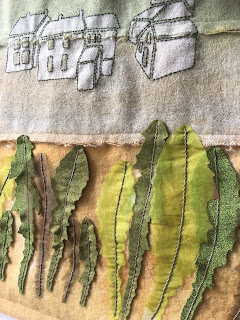For those of you who have kindly followed my blog over the last few months, you will have noticed that my posts have not been as frequent. I have been busy creating some new work for a Textilia 3 exhibition which opens at Cliffe Castle, Keighley next month. This work is a story that has been wrestled out of the landscape!
Like many of their contemporaries, the Butterfield family
rose from humble farmers to wealthy mill owners in a few generations. Following their progress from farmhouse to
Cliffe Castle, I realised that my own house is located on the same road on
which many of Henry Isaac Butterfield’s family lived: the poetically-named “Two Laws and Keighley
Branch of the Toller Lane, Haworth and Bluebell Trust” a turnpike road
constructed between Bradford and Colne.
I walked along the length of the road, sketching the views, the
buildings and the gaps in between.
My wall hangings are constructed from strips of different
fabrics and the composite cloth is hand-dyed.
Each surface texture absorbs the colour in a slightly different way
giving natural pattern and interest. The
final process involves printing outlines of buildings using a bleaching paste.
The first cloth is constructed from cotton and linen. Textile weavers in Keighley started making
cotton but switched to wool when it became more profitable. Contemporary accounts of the textile trade,
indicate that weavers often swapped between materials depending on demand and
price.
The buildings are often grouped in small rows, comprising a
farmhouse, workers cottages and some barns.
They are hunkered down in the landscape to gain some protection from the
prevailing winds.
I have continued the bleaching paste print using fronds of
bracken harvested from the roadside and then embellished this with cotton
organdie and stitch.
 |
| Detail showing bracken print and applique |








